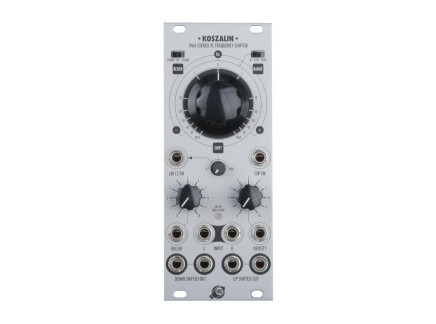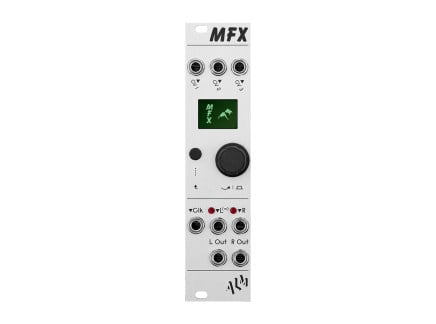The world of effects processing is full of potential, allowing us to turn any sound into something completely unfamiliar, fresh, and exciting. Many of the most easily accessible tools for sound manipulation, though, are designed to execute the same sorts of tricks that musicians have been using for decades: distortion, flangers, phasers, other modulation effects, delays, reverbs, and so on. And while there's plenty of room for creativity in the world of traditional effect processing, there are also plenty of lesser-known and underutilized techniques out there—so today, we're continuing an ongoing conversation about Weird FX and how you can use them.
In our quest to highlight some of our favorite peculiar processing techniques, we've so far covered Fixed Filter Banks (and vocoding!) and Ring Modulation, both excellent ways of completely transforming any sound. Today, we pick up in this article where we left off in our discussion of ring modulation, this time exploring a related-yet-different effect, frequency shifting. Take time time to scope out our Ring Mod article to catch up if you haven't read it already.
In this article, we'll compare ring modulation, frequency shifting, and pitch shifting, take a look at the history of frequency shifting, talk about some of our favorite modern-day frequency shifters, and offer some ideas about how you can use frequency shifting in your own music. Let's dive in!
Frequency Shifters vs. Pitch Shifters—What's the Difference?
When people first hear of frequency shifters, it's easy common to assume that they do the same thing as pitch shifters—after all, in musical terms, aren't frequency and pitch the same thing? Yes, sort of...but actually, the two effects are quite different, each with a distinct sonic character and purpose. To better understand the relationship between frequency shifters and pitch shifters, though, it might be helpful to understand the similarity between frequency shifters and ring modulators.
A ring modulator accepts two signals, a program signal and a carrier signal, and outputs the sum and difference frequencies of the two signals. This results in a peculiar effect, in which a sound is pseudo-pitch-shifted up and down simultaneously, often with a significant destruction of its timbre and a murky sense of pitch—often turning familiar instrument sounds into something abrasive, metallic, and inharmonic. A frequency shifter is actually very similar; it accepts a program and carrier signal, but rather than producing both the sum and difference of the sounds' frequency content, it only produces the sum or the difference between them. In other words, it's basically the same effect as ring modulation, but producing only the upper or lower sideband rather than both.
So knowing that, let's approach the more common question: what's the difference between a pitch shifter and a frequency shifter? Well, both shift the frequency spectrum of a signal by an amount set by the user. In contrast to pitch shifters, the frequency shifter translates a signal's frequency content rather than transposing it. A pitch shifter shifts the energy at all frequencies of the signal by a proportional amount, but frequency shifter shifts the energy at all frequencies by a set number of Hz. This changes harmonic relationships, with harmonic overtones converted into inharmonic partials.
So in perhaps clearer terms, pitch shifters are designed to transpose sounds while maintaining the sound's harmonic profile, so that the transposed results are as similar as possible to the input signal in terms of timbre and clarity. On frequency shifters, however, the greater the amount of shifting, the weirder things get.
Where Did Frequency Shifters Come From?
So like...why would you want to do that? Well, the answer (as with many innovations in signal processing technology) comes from the world of telecommunications. Let's get nerdy for a minute, and then we'll talk about potential applications.
Frequency shifters first appeared in Germany in the 1950s from inventors Ludwig Heck and Fred Buerck. Their frequency shifters incorporated heterodyning in order to shift signals above the audio range with a single-sideband filter. A secondary re-hetereodyning system took these supersonic signals back down into the audio range with a carrier signal that deviated from the original carrier by the amount of desired frequency shift.
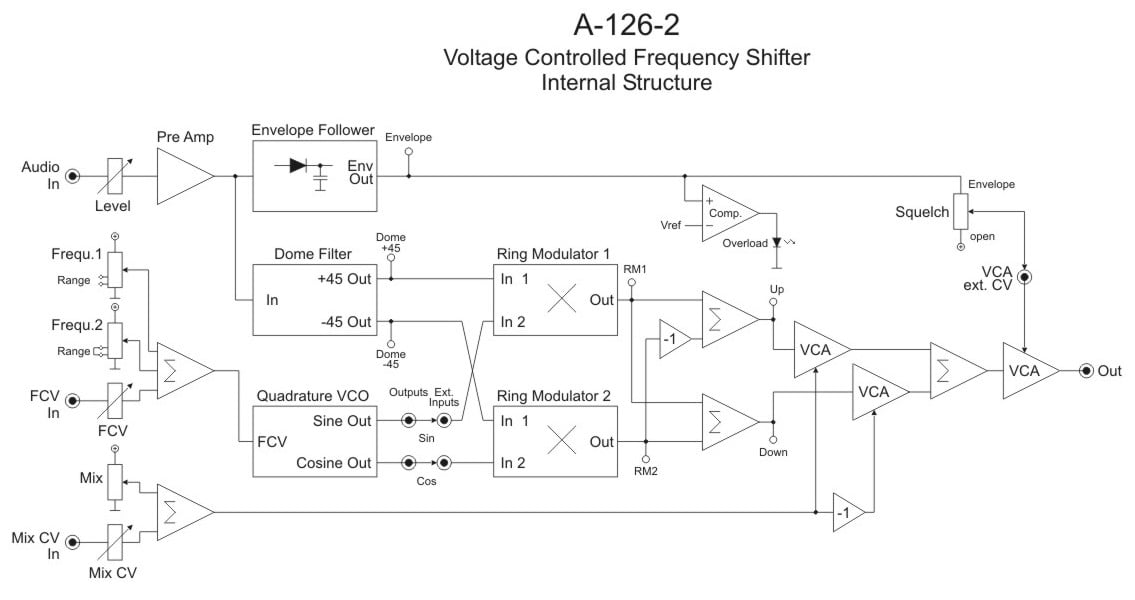
The more commonly-implemented method of frequency shifting combines phase shift and a multiplier. This style of frequency shifter takes the program signal and phase shifts it to create two signals 90 degrees out of phase with each other. To achieve phase shifting, this technique uses a Dome filter, a specialized series of all-pass filters. Rather than affecting the pitch or harmonics of a signal, these all-pass filters change the phase of an incoming signal. As with musical ring modulators, it is most common for an oscillator's output to be normalled to a frequency shifter's carrier input. However, in frequency shifting, typically this carrier is a quadrature oscillator that produces a combination of sine and cosine waves, used to set the shift frequency. Like the Dome filter, the sine and cosine waveforms feature a 90-degree phase offset. The four signals (the output of the two dome filters and the sine/cosine outputs from the oscillator) then pass into two multiplier stages, typically implemented as ring modulators. The product of each multiplication stage is then subtracted from one another—the phase relationship of the signals effectively suppressing one of the sidebands while doubling the other in order to create the frequency-shifted signal. In a nutshell, that's how a frequency shifter works. (Note: this structure is shown above, in the diagram for Doepfer's A-126-2 Frequency Shifter.)
Historically speaking, the Bode Model 735 Frequency Shifter laid the groundwork for many frequency shifters to come, including the Moog adaptation, the Model 1630 Bode Frequency Shifter. It uses the relatively common phase shift and multiplier architecture described above.

The Bode frequency shifter features an internal quadrature oscillator, making classic frequency shifting effects simple to achieve. A six-position scale switch sets the relationship between control sum (a combination of the main shift control and three CV inputs) and frequency shift amount. The six switch positions correspond to a zero-shift calibration mode, four linear modes, and an exponential mode. In exponential mode, the internal oscillator's frequency tracking is calibrated to 1V/oct, allowing the quadrature oscillator to track pitch sequences in conjunction with the input oscillator (and of course, by separately sequencing the carrier and program oscillators, you can construct all sorts of bizarre harmonies that go beyond the typical clangorous frequency shift effects). The four linear modes set the amount of shift with a selection of +5, +50, +500, and +5000Hz to set the overall range of shift, great for honing in on different types of effects from phaser-like to more extreme results. The Bode shifter includes individual outputs for the shift up and down, plus a pair of mixed outputs with a control to balance between the two. An internal squelch circuit eliminates bleedthrough from the carrier by implementing a threshold control which only allows the carrier signal to pass when the program signal passes above that threshold.
Don Buchla’s foray into frequency shifters started with the Model 185 Frequency Shifter. As with many 100 series modules, the design seems quaint and limited by the standards of modern synthesizers. It features no internal reference voltage, but rather a pair of inputs for the program and carrier oscillators. The module outputs the sum and difference between the two signals on separate outputs.
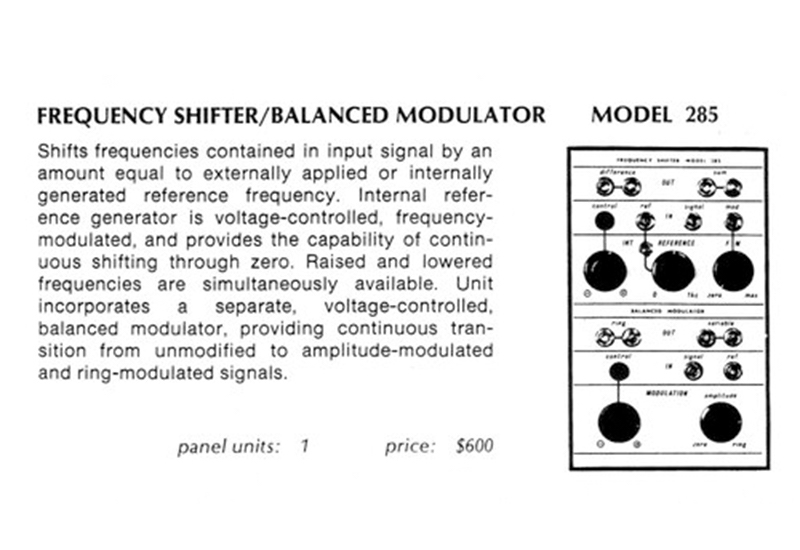 Buchla 285 description from a vintage Buchla 200 Series catalog
Buchla 285 description from a vintage Buchla 200 Series catalog
As with many of the modules, Don Buchla greatly improved upon the groundwork laid with the 100 series modules with the successor, the 200 series. The Model 285 Frequency Shifter/Balanced Modulator combines frequency shifting and balanced modulation—a sensible pairing, given the similarities between these two types of effects. Unlike the 185, this version includes an internal reference oscillator, allowing for immediate access to all manner of wild sounds—or, alternatively, you can patch in your own reference oscillator from elsewhere in the system. The internal thru-zero reference oscillator features both a control input on a banana jack and an FM input on Tini-jax for extended weirdness.
And truthfully, since the Bode/Moog designs and Buchla's frequency shifters, there haven't been many significant developments. Other modular systems did include frequency shifters as well—Polyfusion and Serge, for instance, also offered excellent-sounding options. But, unlike ring modulators, frequency shifters haven't yet crossed over into the "mainstream" end of commercial music gear; there aren't a large number of standalone frequency shifters out there, the effect hasn't yet really marketed to guitarists, it hasn't yet solidifed as a "standard" studio trick, and as such, it is largely overlooked. Now that we've taken a quick tour of frequency shifting's history, though, let's revisit the larger issue—how do you use a frequency shifter? Afterwards, we'll take a look at a couple of our favorite currently-available frequency shifting devices.
So...How Do You Use a Frequency Shifter?
If you've gotten this far without having any specific ideas about how you might actually use a frequency shifter, you're not alone! It's a vastly under-utilized effect, so much so that there are very few "typical" musical uses that we can point to. Because it is so peculiar, there aren't really any go-to frequency shifter tricks—which is tremendously exciting! It leaves the effect open-ended, ripe with potential for exploration. That said, over the years, we have come up with some fun starting points for exploration...so here are a few ideas for things that you can try out with a frequency shifter.
As with ring modulators, the results of frequency shifting can get pretty extreme. They're quite similar to ring modulators in terms of destructive potential, but have a somewhat less drastic character—because they highlight only a single sideband, usually the results aren't quite as spectrally complex, and therefore can fit a bit more seamlessly/predictably into a mix. Generally speaking, if I'm going for that sort of effect, I'll use a ring modulator when I want something more aggressive/edgy and a frequency shifter when I want something more tame in character.
There can be subtlety with frequency shifting however—and by nature of the way that it works, it offers a lot of potential for detuning-style effects not easily possible with ring modulation. In ring modulation, a low-frequency carrier results in a tremolo-like effect in phase with the input signal—so when you blend in the dry signal, you just get a fluctuation in loudness. With frequency shifting, though, slight shifts in frequency mixed with the dry signal result in chorus-like effects. This is especially profound in frequency shifters that allow you simultaneous access to both the up-shifted and down-shifted sidebands; by panning these signals separately from one another in the stereo field, you can achieve swirling choruses even without the dry sound present at all.
Some frequency shifters also include a feedback control. This routes the output of the frequency shifter back to the input, turning the aforementioned chorus-like results into a phasing-type effect. The speed and intensity of the phasing come tied both to the program and carrier oscillator’s pitch and harmonic content.
One of my favorite classic frequency shifting effects involves inserting a frequency shifter into the feedback loop of a delay line. A classic trick from early electronic music, this technique was famously exploited by Trautonium player/composer Oskar Sala, who virtually always played the Trautonium with this sort of delay/frequency shifter setup (see this video for a spectacular and quite clear example of how he employed this effect in performance).
This technique pre-dates the "pitch shifted delay" style effects of early Eventide processors, and has a perhaps more peculiar sound altogether. By inserting the frequency shift effect into a delay's feedback loop, you can create effects where echoes gradually smear up or down in pitch, become less and less similar to the input sound with each repeat. This same trick can be done with a ring modulator, but the effects with a frequency shifter are much cleaner and have a single, very clear pitch trajectory. At higher shift amounts, this can create bell-like twinkling repeats, and at lower shift amounts, it can turn into sounds not dissimilar to an airplane taking off. By altering the shift amount as the repeats ring out, you can create echoes that cascade up and down in pitch—all in all, this technique has a huge range of potential for turning even single notes or percussive sounds into spiraling, otherworldly echoes.
Also worth noting—a frequency shifter's up and down shift outputs can lead to wildly different types of affect than one another. Hypothetically, upward frequency shifting has no limit to "typical" operation—the higher the shift amount, the higher the frequency range of the output of the entire process. This isn't entirely true of downward frequency shifting, however: what happens when you shift a signal below zero Hertz? Well, the result is a thru-zero shift in which the perceived pitch of the sound actually begins to increase again, despite the fact that you're shifting farther and farther down. For instance, a 500Hz sine wave frequency shifted down by 700Hz will actually produce a 200Hz signal. With more complex sounds, this can lead to peculiar spectral mirroring effects: if you shift down far enough, you can actually invert the entire spectrum of a sound, turning it into something entirely unlike its original form.
Perhaps not quite as musically exciting, but certainly a practical use: another common application for a frequency shifter is to reduce feedback in PA systems. By placing a frequency shifter between the mixer and amplifier and subtly shifting the frequency, this greatly reduces feedback without a perceptible change in the ears of the audience. This removes the regeneration effect key in microphone/speaker feedback that results in the characteristic howl of a PA system. The quite famous and well-regarded Polyfusion 755 Feedback Eliminator, for instance, is a frequency shifter with a limited shifting range (up to 6Hz)—a subtle enough range that destructive spectral effects are undetectable, while effectively eliminating the risk of feedback.
This concept can be applied to feedback in synthesis as well. If you're creating a complex patch that relies on audio feedback, you can often tame the bombastic effects of no-input-mixing-style screeches by adding frequency shifters at key points in your signal chain, allowing for easier control and an expanded sonic palette. By dynamically varying the shift amount (perhaps with an envelope follower that tracks your patch's signal level), you can help reign in even the gnarliest of patches—or of course, at extreme shift frequencies, you can use this technique to make things even gnarlier.
Eurorack Modular Frequency Shifters
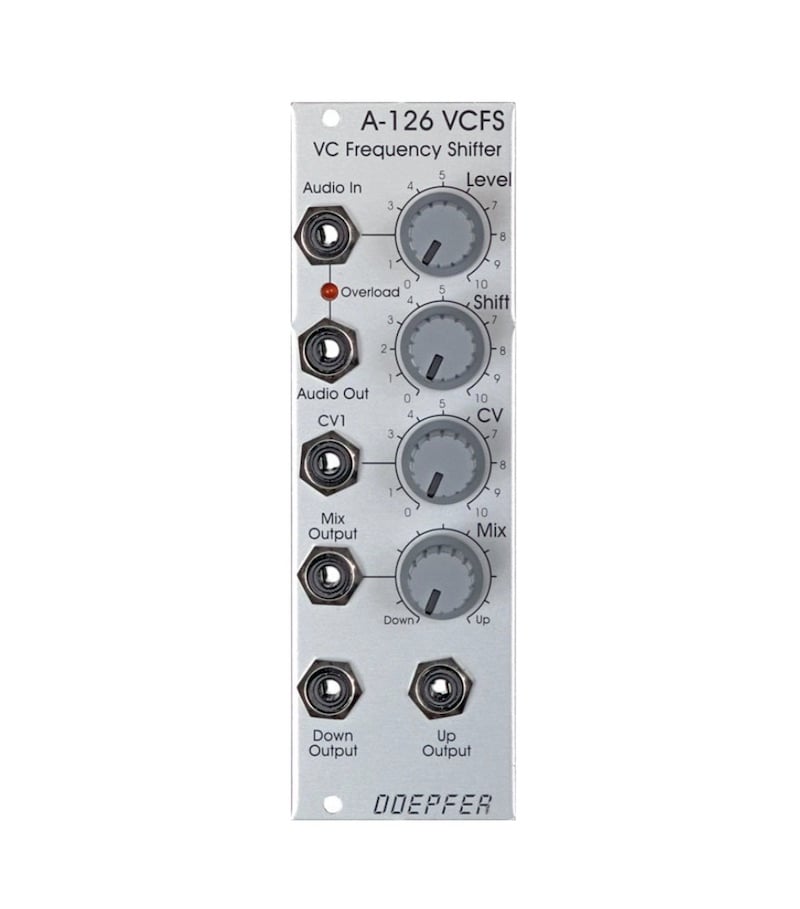 The original Doepfer A-126 VC Frequency Shifter
The original Doepfer A-126 VC Frequency Shifter
Being that the effect never really "caught on" in the same way as phasers, distortions, delay, reverbs, etc., frequency shifters are quite uncommon. Historically, they've most commonly been part of modular synthesizers—and, true to form, most currently available frequency shifters are modules for various formats of synthesizer. Buchla, for instance, produces the 285e—a modern variation on the vintage 285, featuring both balanced modulation and frequency shifting. Synth Werk produces a modern interpretation of the Bode frequency shifter in 5U format as well. Of course, most musicians out there don't have access to a Buchla or 5U system. Happily, though uncommon, there are certainly more accessible frequency shifters out there, so let's take a quick look at a couple: one in Eurorack format, and the other in guitar pedal format.
One of the first Eurorack frequency shifters came, no surprise, from Dieter Doepfer: the A-126 VC Frequency Shifter. It featured an audio input with level and a dedicated output for routing the same signal elsewhere in the modular system, particularly useful for mixing with the output signal for dry/wet mixing. The shifting ranged from 5–5000Hz with CV control over shift frequency. Outputs included separate outputs for the up and down shifted signals, plus a mix output with dedicated mix control. These occasionally crop up on the used market, but it's worth noting that it is an excessively deep module by modern standards: over 100mm deep, in fact, making it impossible to install in most modern Eurorack cases. It was discontinued years ago—and some of the only alternatives, such as the Modcan Dual Frequency Shifter and Synthesis Technology Deflector Shield, have been similarly laid to rest in recent years.
Doepfer has introduced the A-126-2, available with either a silver panel or a black panel, which takes the basic groundwork laid out by the A-126 and improves upon it significantly. The carrier VCO now features both coarse and fine tuning control to precisely dial in the shift frequency. The output of the internal VCO features normalled connection to the ext. VCO inputs, but plugging a jack into either one of the ext VCO inputs overrides the internal carrier oscillator and allows for any signal in your Eurorack system to control the shifting, great for extended sonic experimentation. The integrated squelch circuit uses a VCA and envelope follower to tracks the signal at the audio input and controls the final output VCA, preventing unwanted bleed from the carrier when the audio input is silent or near-silent. The VCA also features a dedicated CV input, which overrides the internal envelope and allows for control over the output amplitude. Doepfer removed the individual outputs for the up and down shifted signals, and condensed them into a single mix output, featuring both manual and CV control over the mix between the two frequency shifted signals. And perhaps best of all, it's not nearly as deep as its predecessor: at only 55mm deep, it won't fit into every case out there, but it's a vast improvement over the original version. (Note: the internal quadrature oscillator on the A-126-2 only goes down to around 20Hz—so if you want to experiment with lower shift frequencies, it is best paired with an A-110-4, A-110-6, or similar quadrature oscillator.)
Even more recently, Xaoc Devices introduced their Koszalin, which takes a somewhat more stylized/less by-the-book approach to frequency shifting. Koszalin is a fully stereo digital frequency shifter with an internal quadrature oscillator, making frequency shifting stereo voices, subgroups, or entire stereo mixes a breeze. It includes separate stereo outputs for the up-shifted and down-shifted signals, making it possible to derive four related outputs from your input signal.
Koszalin's big front-panel shift knob controls the shift amount, and offers three frequency ranges: -50Hz to +50Hz, -500Hz to +500Hz, and -5kHz to +5kHz. This makes it easy to dial in everything from subtle to extreme shifts. We've found that the +/-50Hz range is great for dialing in more chorus/phaser-like responses, while the +/-5kHz range is good for spectral inversion tricks and more extreme Cyberman-style shift effects. What's even better is that the internal quadrature oscillator has two CV inputs—a linear thru-zero FM input with dedicated attenuator, and an exponential CV input whose intensity changes with the selected frequency range.
The Regen controls allow access to internal feedback with variable intensity. You can use the front-panel "regen" switch to select feedback from the down-shifted, up-shifted, or both signals simultaneously—creating a huge range of feedback effects from swimming barber-pole phaser-like tones to all-out evolving screams and screeches. The character of the feedback sound can be varied using the Density knob. If you're looking for a dedicated easy-to-use, great-sounding stereo frequency shifter, Koszalin is a solid option.
That said, Koszalin isn't the only game in town. While we wouldn't hesitate to recommend it for those looking for a dedicated frequency shifter, we recognize that frequency shifting is, well, an esoteric effect that may not find a use in every patch. That said, we'd like to take this opportunity to point you toward one of our current favorite modules altogether: ALM's MFX multi-algorithm effect processor. One of the things that first grabbed our attention about MFX was its excellent delay and reverb algorithms, each of which are worth the price of admission alone. However, there's also an excellent mode called "Ring + Freq Modulator," which can be set to either ring modulation or frequency shifting modes (in mono or stereo!). The frequency shifter mode offers a high cut function as well as an envelope follower for control of the shifted signal's dynamics. Note, though, that as of the time of writing, the Shift mode only allows for upward frequency shifting in the range of 0Hz–1kHz...so downward shifts aren't possible. So, while MFX's frequency shifting algorithm isn't as fully-featured as Koszalin, for instance, it's another solid option for those who want to explore frequency shifting while also getting a boatload of other wonderful effects in their rack.
Frequency Shifters in Effect Pedals
It's super exciting to have so many frequency shifters available again in Eurorack format...for several years, they were quite hard to come by. But what if you're not a modular user, though? Well, regrettably, there aren't a lot of standalone frequency shifting options out there at the moment...however, it's not altogether uncommon to find frequency shifting as a function within another device. So, despite the fact that you won't find too many dedicated frequency shifters out there, you well might be able to find one packed into another tool. In the pedal universe, two awesome examples of this come immediately to mind: Red Panda's Raster 2 and the Alexander Pedals Syntax Error 2.
Red Panda's Raster 2 is a digital delay pedal...but a delay pedal with a ton of tricks hiding beneath its surface. While it excels at creating clean, classic delay effects—including everything from warbling stereo delay to tight slapbacks or even comb filtering—one of its most interesting features is the inclusion of a pitch shifter and frequency shifter option. These days, pitch-shifted delays aren't altogether uncommon; in fact, we wrote another Weird FX article all about them. But adding a frequency shifter to a delay pedal can be quite interesting...as described above, this makes it possible to do some truly trippy spiraling echoes and gradually-deforming repeats. Notably, the frequency shifter on Raster can shift up or down, with control of the shift direction parameterized across a single knob...with no shift at 12:00, upward shift to the right, and downward shift to the left.
On Raster 2, you have a choice of frequency shifting or pitch shifting—and the selected shift effect can be inserted at one of a few different places in the pedal's internal signal path. Shifting can be applied after the delay line, in which case all repeats are shifted by an equal amount; alternatively, shifting can be applied within the delay feedback loop, making it such that repeats are progressively shifted up or down by a greater amount with each repeat. Lastly, you can combine reverse delay effects with shifting in the feedback loop...enabling effects similar to Eventide's "Crystals" or Mode 7 on the Boss PS-3 (described above). You can also shift by separate amounts in the left and right output channels, allowing for all types of peculiar stereo images. And while many of the pedal's tricks are about combining pitch shifting/frequency shifting with delay, you could always set your delay time and feedback to their minimum values, and simply use the pedal as a pitch shifter or frequency shifter alone. Of course, experimenting with different delay and feedback levels will take you far, and you'll be able to achieve everything from stereo phaser-like effects to all-out, self-oscillating frequency-shifted insanity.
Combine all of this with Raster 2's robust MIDI implementation, its ease of configuration, and its all-around excellent sound quality, and you'll quickly realize it's one of the most interesting pedals available altogether.
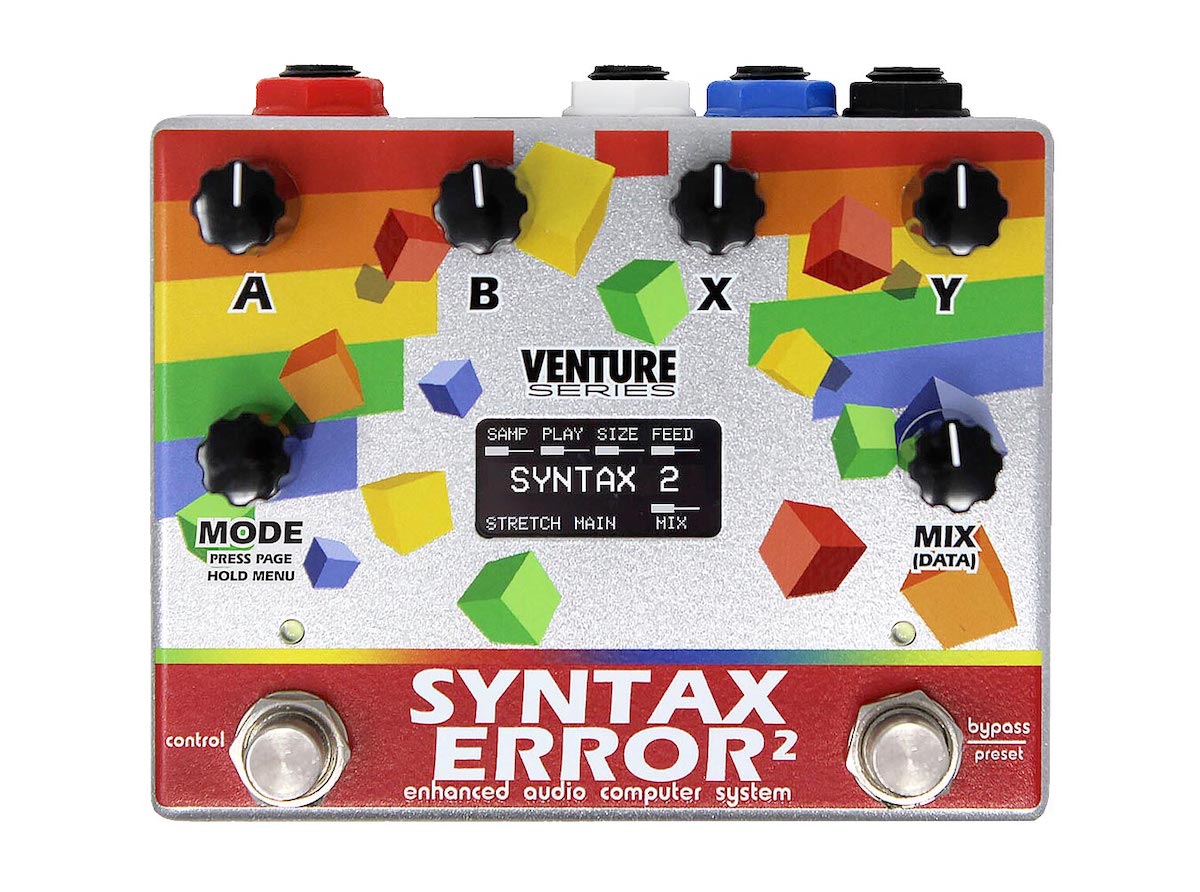
Alexander Pedals's Syntax Error 2 takes a not-dissimilar approach: it's a multi-modal effect pedal that provides access to a number of peculiar different audio effects, from experimental delay/reverb-like processes, downsampling, and ring modulation all the way to—you guessed it—frequency shifting. In the frequency shifting mode, you have seamless access to upward and downward shifting, continuous feedback level control, and an integrated delay effect—in which the delay line is fed back through the frequency shifter for (once again!) swirling, trailing echoes. Like all other modes, you're also given access to sample rate reduction, pitch shifting, volume control, and tone control...and of course, Syntax Error has a number of other peculiar built-in niceties: expression pedal control for smoothly morphing between different parameter settings, a built-in four-step parameter sequencer, and MIDI control of all parameters. If you're looking for a frequency shifter and are interested in something that explores quirky and starkly digital angles on audio processing, Syntax Error 2 just might be the thing.
Shifting Onward
While frequency shifters sound like their primary use case would be shifting the pitch of a signal, they equally affect the timbre of a signal. The uniform shifting of signals with no regard to preserving harmonic relationships creates their characteristically unique sound. The modern realm of effects processing offers little in the way of available options, but perhaps looking to past technology will inspire new makers to revisit this iconic sound.
As with many effects, the "purpose" of frequency shifting isn't written in stone. As such, we see it as an area well worth dedicated exploration; no doubt that in time, you'll find sounds you haven't ever heard before. And of course, this isn't our last exploration into the world of Weird FX: stay tuned for the peculiar tones of CMOS-driven pitch detection and harmonization—the Phase Locked Loop.



